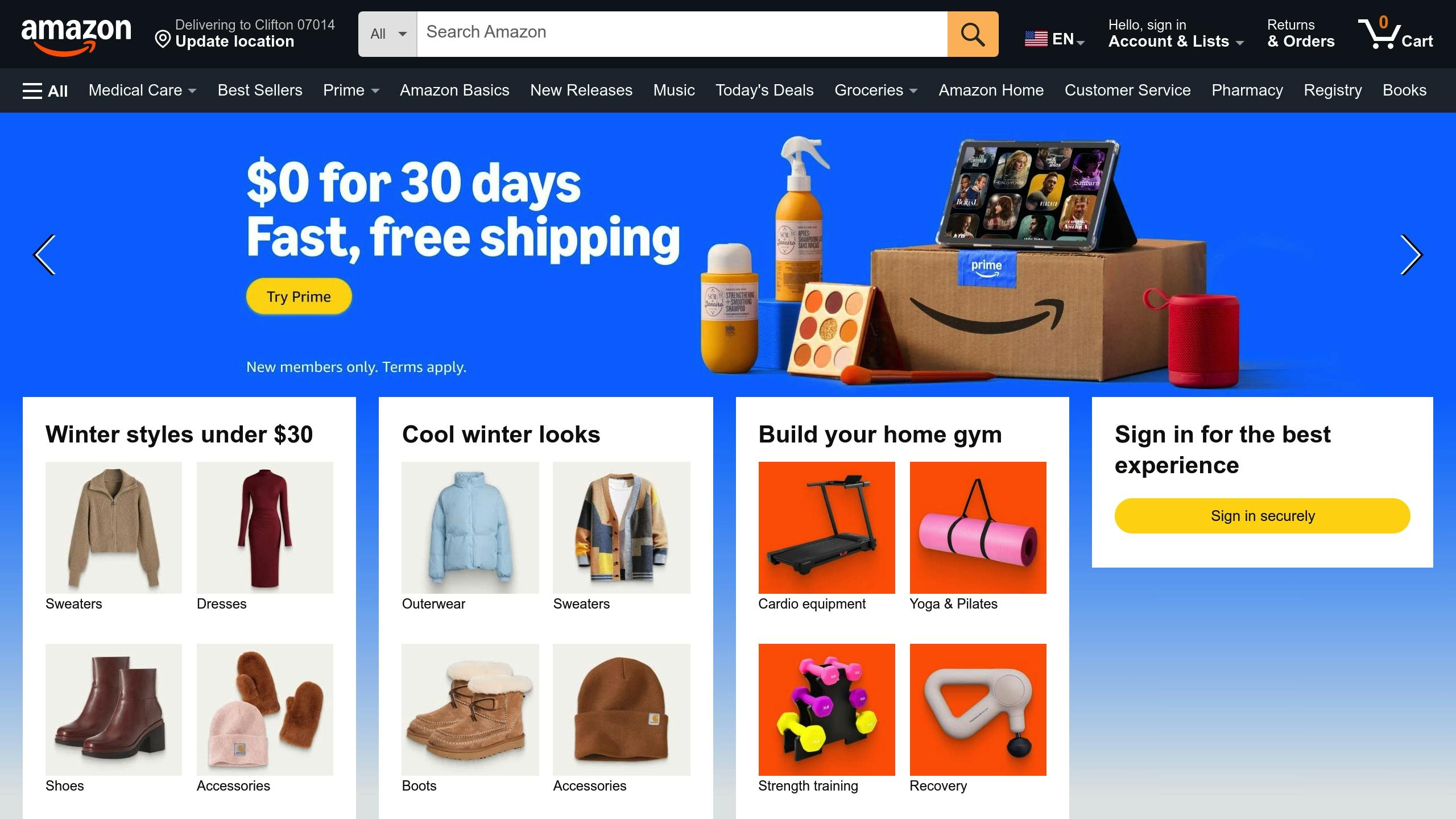
- Harsh Maur
- February 18, 2025
- 6 Mins read
- Scraping
How does Amazon review Scraper help you to boost your product business?
Amazon review scrapers can help your business grow by turning customer feedback into actionable insights. These tools collect Amazon reviews automatically, saving time and helping you analyze trends, fix product issues, and stay ahead of market demands.
Key Benefits:
- Understand competitors: Spot gaps in the market and improve your offerings.
- Improve your products: Identify flaws and enhance customer satisfaction.
- Track trends: Discover emerging customer preferences like "eco-friendly" products.
Using scrapers responsibly ensures data accuracy and avoids risks like account suspensions. Whether you choose tools like Helium 10 or custom Python scripts, this guide will show you how to set up, analyze, and apply review data for better business results.
How Review Scrapers Help Grow Your Business
Amazon review scrapers can drive business growth by focusing on three main areas:
Understand and Outperform Competitors
By analyzing competitor reviews, you can uncover:
- Common complaints about their products
- Features customers wish they had
- Trends in customer satisfaction
- Gaps in the market that competitors aren’t addressing
Improve Your Products
Scraped review data pinpoints product flaws, allowing you to fix them before they hurt your brand.
For example, a kitchenware company used review scraping to discover ergonomic issues with its pot handles. After redesigning the handles, complaints dropped 30%, and ratings boosted 20%. These changes improved customer satisfaction and enhanced product rankings and loyalty.
Stay Ahead of Market Trends
Review scrapers can highlight shifting customer preferences, giving you a head start on adapting.
Take a beauty product manufacturer, for instance. Their review analysis showed a rising interest in sustainable products. By identifying keywords like "eco-friendly" and "sustainable packaging", they were able to:
- Launch new environmentally conscious products
- Gain a competitive edge by acting early
- Increase their market share by 25%
"Continuous analysis helps identify emerging keywords and monitor feature requests to spot trends early."
Key Metrics to Track
Use your scraper to monitor these metrics for actionable insights:
| Metric | Focus | Impact |
|---|---|---|
| Sentiment Trends | Shifts in overall review ratings | Tracks change in customer satisfaction |
| Keyword Frequency | New terms appearing in reviews | Highlights emerging customer demands |
| Feature Requests | Frequently mentioned desired features | Identifies unmet customer needs |
| Seasonal Patterns | Changes in reviews over time | Helps predict demand cycles |
Setting Up Your Review Scraper
Pick the Right Tools
When choosing tools for scraping reviews, consider your business goals and resources. Here are some popular options:
- Helium 10: Great for those who need analytics built right in.
- Jungle Scout: Perfect for startups looking for cost-effective solutions.
- Web Scraping HQ: Tailored for enterprises needing custom setups.
Pick based on your business size and whether you prioritize ease of use or customization.
Setup Steps
Getting the setup right is crucial for collecting accurate and useful data. Here's an example of a Python-based scraper to kick things off:
# Basic Python scraper structure (add error handling for production use)
import requests
from bs4 import BeautifulSoup
def scrape_amazon_reviews(product_url):
headers = {'User-Agent': 'Mozilla/5.0 (Windows NT 10.0; Win64; x64) AppleWebKit/537.36'}
response = requests.get(product_url, headers=headers)
soup = BeautifulSoup(response.content, 'html.parser')
reviews = soup.find_all('div', {'data-hook': 'review'})
return reviews
If you'd rather stick to official tools, Amazon's Product Advertising API is a solid choice. It provides structured data, though it may require some setup. Here's a quick comparison:
| Feature | API | Custom Scraping |
|---|---|---|
| Reliability | High | Less predictable |
| Data Format | Pre-structured | Requires parsing |
Avoid Getting Blocked
Scraping can trigger blocks if not handled carefully. DataHawk, for example, achieved a 99.7% success rate by using residential IP rotation and introducing random delays.
Here are some essential techniques to avoid interruptions:
- Use randomized request intervals (e.g., 5-15 seconds).
- Rotate IPs regularly through a trusted network.
- Employ CAPTCHA-solving systems to bypass restrictions.
With these strategies in place, you can ensure a steady flow of reliable data, ready for analysis and insights.
sbb-itb-65bdb53
Using Review Data Effectively
Once your scraper is up and running, the next step is turning raw data into strategies that can drive real results.
Analyze Review Sentiment
The first step in making sense of review data is sentiment analysis. Tools like TextBlob or VADER use Natural Language Processing (NLP) to automatically classify feedback as positive, negative, or neutral. For larger-scale needs, platforms like Amazon Comprehend offer advanced machine-learning models for deeper insights.
This process involves cleaning and organizing reviews to uncover key themes, such as product durability or ease of use. Sentiment analysis tools can help spot recurring patterns, making it easier to focus on areas that need improvement.
Create Data Reports
Turning raw data into clear, actionable insights requires effective reporting. Tools like Tableau or Power BI can help visualize key trends. Some important metrics to focus on include:
- Rating patterns over time, such as across product updates or seasonal changes
- Sentiment breakdowns, highlighting the balance between positive and negative feedback
- Feature-specific mentions, pointing out common strengths and weaknesses
- Competitor comparisons, showing how your product stacks up
Dashboards combining timelines, sentiment shifts, and visual tools like word clouds can reveal valuable patterns. For example, you might notice a spike in complaints about product durability or consistent praise for a standout feature.
Make Data-Based Changes
Here’s an example: A pet product company noticed frequent complaints about durability in their reviews. By switching to reinforced materials, they saw fewer returns and more repeat purchases. This shows how acting on review data can directly impact sales and customer loyalty.
To keep this process effective, set up regular review cycles and bring together cross-functional teams to implement changes. Track how these updates influence sales, rankings, and customer retention over time.
Wrapping It Up
Once your scraper is up and running, and data is flowing through your analysis systems, the real work begins: putting that data to good use. Amazon review scrapers, when used responsibly, can turn raw customer feedback into actionable insights. The key is to stay ethical and keep refining your approach.
Key Takeaways
Now that your scraper and analysis tools are in place, you can start turning customer feedback into strategies that drive results. Ethical practices go beyond just following rules - they involve ongoing monitoring and improving how you collect and use data.
FAQs
Is it possible to scrape Amazon reviews?

Scraping Amazon reviews comes with legal and technical challenges. While a 2019 Ninth Circuit Court ruling clarified that scraping public data doesn't breach the Computer Fraud and Abuse Act, Amazon's terms of service strictly prohibit automated access without permission. This means businesses could face risks like account suspensions or legal actions.
Here are the main methods for collecting review data:
| Method | Benefits | Drawbacks |
|---|---|---|
| Commercial APIs (e.g., Amazon Scraper API) | Reliable and compliance-oriented | Subscription fees and limited flexibility |
| Custom scrapers (e.g., BeautifulSoup, Scrapy) | Full control and no recurring costs | Requires technical skills and ongoing upkeep |
| Third-party datasets | Quick access with lower legal risk | This may include outdated or narrowly focused data |
For most businesses, tools like Amazon Scraper API or ParseHub offer a practical mix of ease and compliance. These services handle common challenges, such as website updates and anti-scraping defenses, without requiring technical expertise.
If you're new to this, start with commercial APIs or third-party datasets to test your approach before investing in custom-built solutions. Always consider using Amazon's official API and consult legal experts to ensure compliance.
FAQs
Find answers to commonly asked questions about our Data as a Service solutions, ensuring clarity and understanding of our offerings.
We offer versatile delivery options including FTP, SFTP, AWS S3, Google Cloud Storage, email, Dropbox, and Google Drive. We accommodate data formats such as CSV, JSON, JSONLines, and XML, and are open to custom delivery or format discussions to align with your project needs.
We are equipped to extract a diverse range of data from any website, while strictly adhering to legal and ethical guidelines, including compliance with Terms and Conditions, privacy, and copyright laws. Our expert teams assess legal implications and ensure best practices in web scraping for each project.
Upon receiving your project request, our solution architects promptly engage in a discovery call to comprehend your specific needs, discussing the scope, scale, data transformation, and integrations required. A tailored solution is proposed post a thorough understanding, ensuring optimal results.
Yes, You can use AI to scrape websites. Webscraping HQ’s AI website technology can handle large amounts of data extraction and collection needs. Our AI scraping API allows user to scrape up to 50000 pages one by one.
We offer inclusive support addressing coverage issues, missed deliveries, and minor site modifications, with additional support available for significant changes necessitating comprehensive spider restructuring.
Absolutely, we offer service testing with sample data from previously scraped sources. For new sources, sample data is shared post-purchase, after the commencement of development.
We provide end-to-end solutions for web content extraction, delivering structured and accurate data efficiently. For those preferring a hands-on approach, we offer user-friendly tools for self-service data extraction.
Yes, Web scraping is detectable. One of the best ways to identify web scrapers is by examining their IP address and tracking how it's behaving.
Data extraction is crucial for leveraging the wealth of information on the web, enabling businesses to gain insights, monitor market trends, assess brand health, and maintain a competitive edge. It is invaluable in diverse applications including research, news monitoring, and contract tracking.
In retail and e-commerce, data extraction is instrumental for competitor price monitoring, allowing for automated, accurate, and efficient tracking of product prices across various platforms, aiding in strategic planning and decision-making.